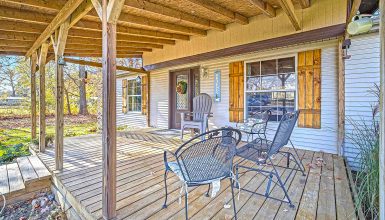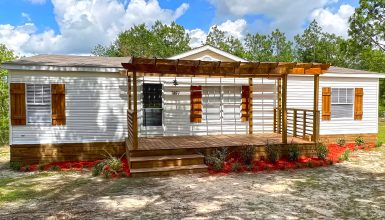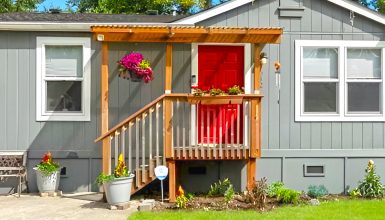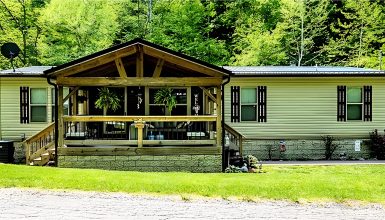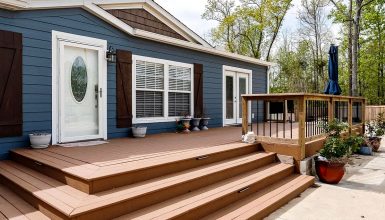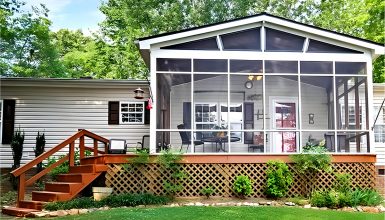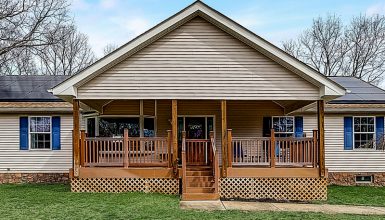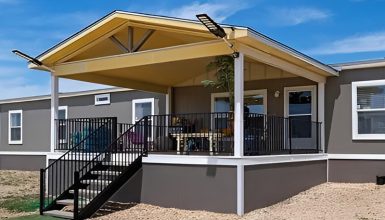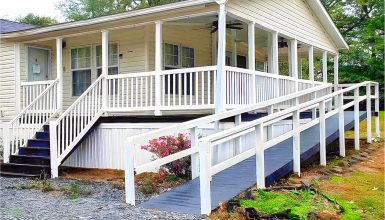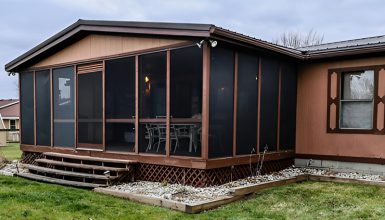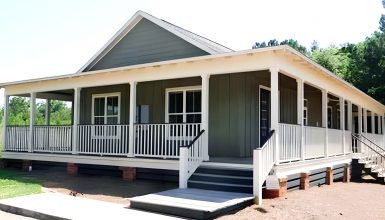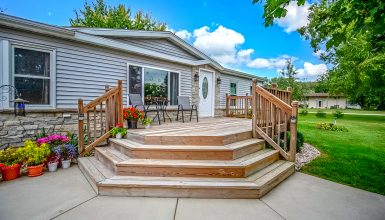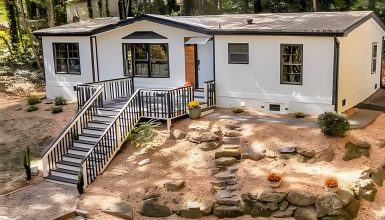Front porches on mobile homes are more than just a space. They’re where you enjoy morning coffees and evening chats and watch the world go by. But, like any part of a home, they face issues. Think of weak supports that make the porch shaky or a leaking roof, which makes a rainy day gloomy. Railings can get wobbly, and pests might sneak in. It’s not just about the looks; it’s about safety and comfort too. So, let’s dive into these common problems and how to fix them.
1. Weak Supports
Have you ever stepped onto your porch and felt a bit of a wobble? That’s a sign of weak support. It’s like having a wobbly chair at a dinner table. Not fun, right? Weak supports can be due to age, weather, or just wear and tear.
Here’s how to fix it:
- First, check all the support beams. Look for cracks, bends, or rust if they’re metal.
- Next, grab some tools. You’ll need new wood or metal supports, brackets, screws, and a drill.
- Replace the damaged supports with new ones. If the old ones are wooden, go for treated wood this time. It lasts longer.
- Add extra brackets for more strength. Think of them like a strong friend holding up the porch.
Finally, make sure everything is tight and secure. Give it a good shake to test. If it doesn’t move, you’re all set!
2. Leaking Roofs
A leaking roof can turn a relaxing porch sit into a wet surprise. But finding the leak source can be like a detective game.
Here’s how to solve this mystery:
- First, look for obvious signs. Are there missing or damaged shingles? Is the sealing around the edges cracked?
- If you find missing shingles, it’s time for some roof gardening. You’ll need new shingles, roofing nails, and a hammer. Carefully remove the damaged ones and nail the new ones in place.
- For cracked seals, a sealant is your best friend. Clean the area first, then apply a roof sealant. It’s like putting a band-aid on a cut.
- Make sure to cover all the gaps. It’s like painting but with more purpose.
- After you’re done, wait for the next rain. If you stay dry, you’ve done it!
3. Wobbly Railings
Wobbly railings on your porch aren’t just annoying; they can be a safety hazard, especially if you lean on them. Most times, they get loose because the screws or bolts holding them have loosened over time. Weather changes and regular use can also cause this.
Here’s how to fix them:
- Start by checking each railing post. Wiggle them a bit to see which ones are loose.
- Once you find the culprits, grab a screwdriver or a wrench. Tighten all the loose screws or bolts. Sometimes, that’s all it takes!
- If the railing is still shaky, it might be time for a replacement. Measure the old railings and get new ones that match.
- Installing new railings? Make sure you drill them in firmly. Use weather-resistant screws so they last longer.
- Give them a test shake. If they stay firm, you’ve done a great job!
4. Rotting Wood
Rotting wood on your porch is like a bad apple in a basket; you must take care of it before it worsens. Look out for soft, spongy spots or wood that crumbles easily. Discoloration and a musty smell are also tell-tale signs.
Here’s how to replace it:
- First, you’ll need to remove the rotten wood. Use a saw or a chisel, but be careful not to damage the good wood around it.
- Measure the area you’ve just cleared. Now, cut a piece of new, treated wood to fit this space.
- Treated wood is key here. It resists rotting better than regular wood.
- Fit the new piece in and secure it with weather-resistant screws. You might need a drill for this.
- For extra protection, you can paint or seal the wood. This step helps to keep water and pests out.
5. Poor Drainage
Poor drainage on your porch can be a real party pooper. When water pools up, it can lead to slippery surfaces, wood rot, and even weaken your porch’s foundation. It’s like leaving a sponge soaked in water; eventually, it will have issues.
So, how do you fix this?
- First, check the slope of your porch. It should gently slope away from your house, guiding water to where it should go.
- If the slope is off, consider adding a slight incline. This doesn’t mean a big renovation. Sometimes, just adding or adjusting some boards can do the trick.
- Next, think about gutters and downspouts. They’re like raincoats for your porch, directing water away.
- Ensure the downspouts point away from the porch and water flows freely through the gutters. It’s like making a path for rain to follow.
6. Pest Infestation
Pests, especially termites, can turn your lovely porch into their dining room. Termites love wood, and they’re not polite guests. They can cause serious damage if left unchecked.
Here’s how to keep these uninvited guests away:
- Regular checks are essential. Look for signs like tiny holes in the wood, sawdust piles, or even termites.
- If you spot termites, it’s time to call in the pros. Pest control experts can treat the area with chemicals that keep termites at bay.
- For prevention, keep wood dry and treated. Termites love damp wood, so keeping things dry is like keeping snacks away from a hungry toddler.
- Also, consider using termite-resistant materials for any new porch work. It’s like building a fortress against these tiny invaders.
7. Uneven Flooring
Uneven flooring on your porch is like walking on a bumpy road; it’s not smooth and can be a tripping hazard. Over time, boards can warp or shift, causing these uneven spots.
Here’s how you can fix them:
- First, you need to spot the problem areas. Take a good look. Do you see any warping or feel any bumps as you walk?
- Use a level tool to check how uneven it is. It’s a handy gadget that shows if things are level.
- Once you’ve found the uneven spots, it’s time to level them. If the boards are just a bit warped, you can sand them down. It’s like giving your porch a mini spa treatment.
- For more severe unevenness, replacing the boards might be best. Measure, cut, and fit new boards, ensuring they sit flat and even.
- Secure the new boards with screws, and there you have it, a smooth, even porch floor.
8. Fading Paint
Fading paint on your porch doesn’t just make it look old and tired. It’s a sign that the elements – sun, rain, wind – are wearing it down.
But don’t worry, here’s how to bring it back to life:
- First, understand why the paint is fading. Too much sun? Harsh weather? It’s like diagnosing why a plant might be wilting.
- Once you know the cause, choose the right paint. Go for weather-resistant paint. It’s tough and can handle what nature throws at it.
- Before painting, prep the area. Clean the surface, and scrape off any old, flaking paint. It’s like preparing a canvas for a masterpiece.
- Now, start painting. Use even strokes and cover all areas well. You might need a couple of coats.
- Let it dry, and voilà! Your porch is not only looking great but also has a strong shield against the weather.
9. Loose Steps
Loose steps on your porch are like a wiggly tooth; they need attention before they cause a stumble. Steps can loosen over time due to regular use or weather effects.
Here’s how to secure them:
- Start by giving each step a good test. Press down and see if they move or make noise.
- If they wiggle, it’s time to tighten things up. Get a screwdriver or a drill. Tighten all the screws or bolts on the steps. It’s like making sure the lids on jars are tight so nothing spills.
- Sometimes, screws just won’t do. In that case, you might need to replace a step or two. Measure the old step, get a new piece of wood cut to size, and fit it in.
- Secure the new step with screws. Make sure it’s snug and doesn’t move.
10. Insufficient Lighting
Good lighting on your porch is like having the right amount of sunlight for a plant. It makes the space inviting and safe. When it’s dark, you risk missing a step or not seeing where you’re going.
Let’s brighten things up:
- First, think about where you need light the most. Is it the steps, the seating area, or the whole porch?
- There are many lighting options. String lights can create a cozy atmosphere. They’re like stars twinkling above your porch.
- Solar-powered lights are great for steps and walkways. They charge during the day and light up at night, like little night-time guardians.
- For more brightness, consider wall-mounted lights or a porch ceiling light. These are like a steady hand guiding you in the dark.
When choosing lights, look for weather-resistant ones. They need to withstand sun, rain, and wind.


